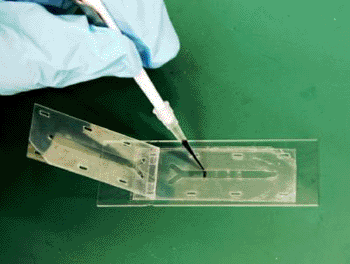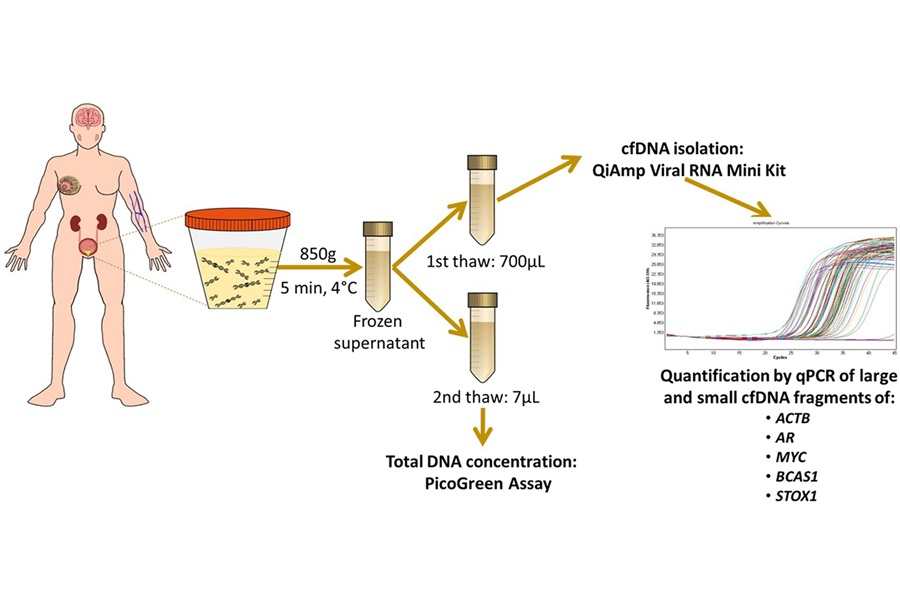Microfluidic Devices Created from Ordinary, Inexpensive Components
|
By LabMedica International staff writers Posted on 16 Feb 2012 |

Image: NIST scientists combined a glass slide, plastic sheets, and double-sided tape to create an inexpensive and simple-to-build microfluidic device for exposing an array of cells to different concentrations of a chemical (Photo courtesy of Cooksey/NIST).
A glass slide, plastic sheets, and double-sided tape were combined to create a diffusion-based gradient generator, a tool that rapidly assesses how changing concentrations of specific chemicals affect living cells.
Exposing an array of cultured cells to a chemical gradient provides a solution where the chemical concentration changes gradually and predictably across the array. Such gradients are a rapid, high-throughput way to evaluate the effect on cell growth or toxicity.
Created by National Institute of Standards and Technology (NIST; Gaithersburg, MD, USA) engineer Javier Atencia the gradient generator is built in layers, with each section precisely positioned with an alignment tab. The base is a glass slide, upon which is attached a strip of double-sided tape cut to have a row of four micrometer-sized channels. On top of this is placed a polystyrene strip cut to have two lines each of four tiny circular "wells" where each pair lines up with the ends of the channel below it. The next layer is another strip of double-sided tape, this time with a Y-shaped canal cut into it to serve as the flow path for the chemical gradient. Finally, a Mylar strip cut to have an identical Y-canal serves as the cover.
The hinged cover allows access to the wells for adding test cells. Once done, the cover is lowered and affixed, sealing the gradient generator. Fluid flow in and out of the system is accomplished using magnetic connectors. Under constant pressure, the flow assures a steady-state stream through the device and creates a diffusion gradient in each buried channel. Cells in the channels are simultaneously exposed to a range of chemical concentrations from high to low.
Conventional microfluidic systems usually mix fluids by pumping them in a circular motion or by twisting and folding them together. The new NIST system's gradient is created by diffusion––the gentle movement of matter from one point to another by random molecular motion. This greatly reduces the risk of cells being swept away or damaged by shearing forces in the test fluid.
The device was tested by loading it with cells genetically engineered to produce large amounts of green fluorescent protein (GFP) and then introduced cycloheximide (CHX), a chemical that shuts down ribosomes, the cell's protein factories. Cells exposed to the toxin quickly stop synthesizing GFP, decreasing fluorescence by an amount directly related to the concentration of CHX.
This is what the scientists observed in the gradient generator assays. The cells were exposed three times to CHX, and each time, the level of GFP fluorescence increased as the concentration of CHX in the gradient decreased, and vice versa.
The new device was described in the 2012 edition of the journal Lab-on-a-Chip.
Related Links:
National Institute of Standards and Technology
Exposing an array of cultured cells to a chemical gradient provides a solution where the chemical concentration changes gradually and predictably across the array. Such gradients are a rapid, high-throughput way to evaluate the effect on cell growth or toxicity.
Created by National Institute of Standards and Technology (NIST; Gaithersburg, MD, USA) engineer Javier Atencia the gradient generator is built in layers, with each section precisely positioned with an alignment tab. The base is a glass slide, upon which is attached a strip of double-sided tape cut to have a row of four micrometer-sized channels. On top of this is placed a polystyrene strip cut to have two lines each of four tiny circular "wells" where each pair lines up with the ends of the channel below it. The next layer is another strip of double-sided tape, this time with a Y-shaped canal cut into it to serve as the flow path for the chemical gradient. Finally, a Mylar strip cut to have an identical Y-canal serves as the cover.
The hinged cover allows access to the wells for adding test cells. Once done, the cover is lowered and affixed, sealing the gradient generator. Fluid flow in and out of the system is accomplished using magnetic connectors. Under constant pressure, the flow assures a steady-state stream through the device and creates a diffusion gradient in each buried channel. Cells in the channels are simultaneously exposed to a range of chemical concentrations from high to low.
Conventional microfluidic systems usually mix fluids by pumping them in a circular motion or by twisting and folding them together. The new NIST system's gradient is created by diffusion––the gentle movement of matter from one point to another by random molecular motion. This greatly reduces the risk of cells being swept away or damaged by shearing forces in the test fluid.
The device was tested by loading it with cells genetically engineered to produce large amounts of green fluorescent protein (GFP) and then introduced cycloheximide (CHX), a chemical that shuts down ribosomes, the cell's protein factories. Cells exposed to the toxin quickly stop synthesizing GFP, decreasing fluorescence by an amount directly related to the concentration of CHX.
This is what the scientists observed in the gradient generator assays. The cells were exposed three times to CHX, and each time, the level of GFP fluorescence increased as the concentration of CHX in the gradient decreased, and vice versa.
The new device was described in the 2012 edition of the journal Lab-on-a-Chip.
Related Links:
National Institute of Standards and Technology
Latest Technology News
- Artificial Intelligence Model Could Accelerate Rare Disease Diagnosis
- AI Saliva Sensor Enables Early Detection of Head and Neck Cancer
- AI-Powered Biosensor Technology to Enable Breath Test for Lung Cancer Detection
- AI Model Achieves Breakthrough Accuracy in Ovarian Cancer Detection
- Portable Biosensor Diagnoses Psychiatric Disorders Using Saliva Samples
- Cell-Sorting Device Uses Electromagnetic Levitation to Precisely Direct Cell Movement

- Embedded GPU Platform Enables Rapid Blood Profiling for POC Diagnostics
- Viral Biosensor Test Simultaneously Detects Hepatitis and HIV
- Acoustofluidic Device to Transform Point-Of-Care sEV-Based Diagnostics
- AI Algorithm Assesses Progressive Decline in Kidney Function
Channels
Clinical Chemistry
view channel
Chemical Imaging Probe Could Track and Treat Prostate Cancer
Prostate cancer remains a leading cause of illness and death among men, with many patients eventually developing resistance to standard hormone-blocking therapies. These drugs often lose effectiveness... Read more
Mismatch Between Two Common Kidney Function Tests Indicates Serious Health Problems
Creatinine has long been the standard for measuring kidney filtration, while cystatin C — a protein produced by all human cells — has been recommended as a complementary marker because it is influenced... Read moreMolecular Diagnostics
view channel
Simple Urine Test to Revolutionize Bladder Cancer Diagnosis and Treatment
Bladder cancer is one of the most common and deadly urological cancers and is marked by a high rate of recurrence. Diagnosis and follow-up still rely heavily on invasive cystoscopy or urine cytology, which... Read more
Blood Test to Enable Earlier and Simpler Detection of Liver Fibrosis
Persistent liver damage caused by alcohol misuse or viral infections can trigger liver fibrosis, a condition in which healthy tissue is gradually replaced by collagen fibers. Even after successful treatment... Read moreHematology
view channel
Platelet Activity Blood Test in Middle Age Could Identify Early Alzheimer’s Risk
Early detection of Alzheimer’s disease remains one of the biggest unmet needs in neurology, particularly because the biological changes underlying the disorder begin decades before memory symptoms appear.... Read more
Microvesicles Measurement Could Detect Vascular Injury in Sickle Cell Disease Patients
Assessing disease severity in sickle cell disease (SCD) remains challenging, especially when trying to predict hemolysis, vascular injury, and risk of complications such as vaso-occlusive crises.... Read more
ADLM’s New Coagulation Testing Guidance to Improve Care for Patients on Blood Thinners
Direct oral anticoagulants (DOACs) are one of the most common types of blood thinners. Patients take them to prevent a host of complications that could arise from blood clotting, including stroke, deep... Read moreImmunology
view channel
New Test Distinguishes Vaccine-Induced False Positives from Active HIV Infection
Since HIV was identified in 1983, more than 91 million people have contracted the virus, and over 44 million have died from related causes. Today, nearly 40 million individuals worldwide live with HIV-1,... Read more
Gene Signature Test Predicts Response to Key Breast Cancer Treatment
DK4/6 inhibitors paired with hormone therapy have become a cornerstone treatment for advanced HR+/HER2– breast cancer, slowing tumor growth by blocking key proteins that drive cell division.... Read more
Chip Captures Cancer Cells from Blood to Help Select Right Breast Cancer Treatment
Ductal carcinoma in situ (DCIS) accounts for about a quarter of all breast cancer cases and generally carries a good prognosis. This non-invasive form of the disease may or may not become life-threatening.... Read moreMicrobiology
view channel
Rapid Diagnostic Test Matches Gold Standard for Sepsis Detection
Sepsis kills 11 million people worldwide every year and generates massive healthcare costs. In the USA and Europe alone, sepsis accounts for USD 100 billion in annual hospitalization expenses.... Read moreRapid POC Tuberculosis Test Provides Results Within 15 Minutes
Tuberculosis remains one of the world’s deadliest infectious diseases, and reducing new cases depends on identifying individuals with latent infection before it progresses. Current diagnostic tools often... Read more
Rapid Assay Identifies Bloodstream Infection Pathogens Directly from Patient Samples
Bloodstream infections in sepsis progress quickly and demand rapid, precise diagnosis. Current blood-culture methods often take one to five days to identify the pathogen, leaving clinicians to treat blindly... Read morePathology
view channelTunable Cell-Sorting Device Holds Potential for Multiple Biomedical Applications
Isolating rare cancer cells from blood is essential for diagnosing metastasis and guiding treatment decisions, but remains technically challenging. Many existing techniques struggle to balance accuracy, throughput, and cell viability. Size-based methods such as deterministic lateral displacement are attractive, yet conventional... Read moreAI Tool Outperforms Doctors in Spotting Blood Cell Abnormalities
Diagnosing blood disorders depends on recognizing subtle abnormalities in cell size, shape, and structure, yet this process is slow, subjective, and requires years of expert training. Even specialists... Read moreIndustry
view channel
Abbott Acquires Cancer-Screening Company Exact Sciences
Abbott (Abbott Park, IL, USA) has entered into a definitive agreement to acquire Exact Sciences (Madison, WI, USA), enabling it to enter and lead in fast-growing cancer diagnostics segments.... Read more






















